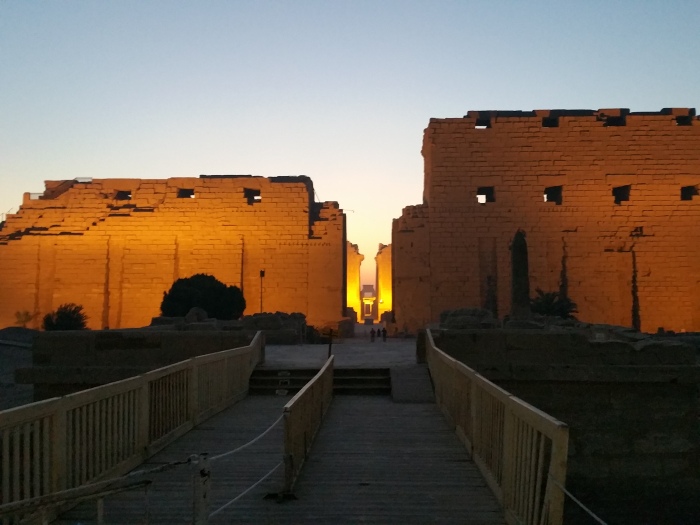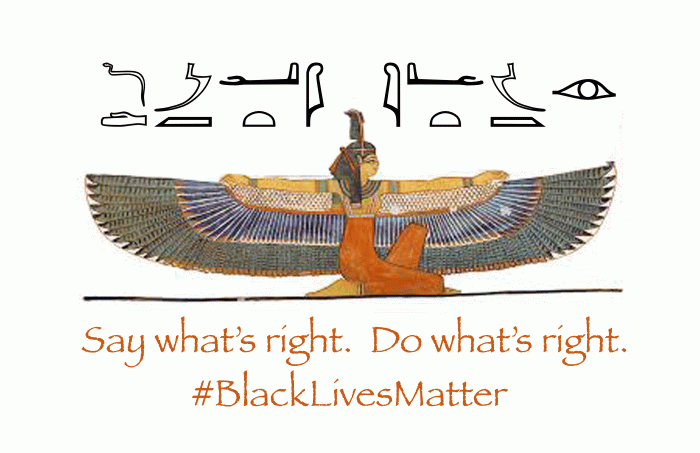
Morning Hymns in various forms are found across the entire time-span of Egyptian religious writing – from Old Kingdom pyramids to Roman temples and papyri. Deities, insignia, architectural elements, spirits in the afterlife, and more were awakened using these hymns – sometimes quite briefly and sometimes in elaborately structured litanies. The longevity and diversity of these texts fascinate me and I’ve discussed them here and even written one here previously.
The focus for this post is a version found in the daily Temple Statue Ritual conducted in Temples (pBerlin 3055, Episode 6. The classic treatment of the Temple Statue Ritual found in Moret, Alexandre Le Rituel du Culte Divin Journalier en Égypte d’Après les Papyrus Berlin et du Temple de Séti Ier, à Abydos, 1902 is now outdated. A more recent treatment is Braun, Nadja, Pharao und Priester – Sakrale Affirmation von Herrschaft durch Kultvollzug: Das Tägliche Kultbildritual im Neuen Reich und der Dritten Zwischenzeit, 2013. I have relied on this text for transliteration and to some extent translation below, while using Moret for his hieroglyphic transcription). It is unique, as far as I know, in that the Deity addressed in the initial stanza (with the pride of place that signifies) is the Goddess who _is_ the Karnak Temple Complex itself (herself!).
We have evidence from the hymn’s position in this papyrus, as well as the locations of examples found in later temples, that the morning hymns were chanted or sung near the beginning of the day’s rituals, close to dawn. We cannot be precisely sure of the sequence of events, which could have varied by circumstance, period, and local custom, but in this case it is placed after “Stepping to the Sacred Place” and before the beginning of the sanctuary entry sequence itself (cutting the papyrus cord of the door seal). Similarly, the elaborate examples at Edfu and Dendera are carved on the outer façade of the Barque Sanctuaries of these temples on either side of the doors, an appropriate place if the hymns were sung before or as the doors of the Sanctuaries were opened in the morning.
In our case the Temple as the Goddess Ipet-Sut (the well-known name of Karnak – “Most Select of Places”) is awakened first, followed by the Shrines and Gods and Goddesses within her. Then widening spheres of deities in various cities, sky, earth, and the four directions follow. Finally, the royal ancestors and their children (presumably the statues of previous Kings and Royal personages who received offerings each day) are wakened.
An interesting aspect of this hymn – in contrast to those at Edfu, Dendara, the Pyramid Texts, and various papyri – is its focus on awakening collectives of Deities. The one individual here is Karnak herself, who is given the epithet “Mistress of the Temples and the Gods and Goddesses within her”. We see the awakening formulas for Amun-Ra (the presiding God of Karnak) as an individual embedded in larger hymns in Episodes 37, 38, and 39 later in the text. (The sequential placement of the episodes in that section of the papyrus is problematic. A number of them are reiterations of earlier episodes while others have titles stating that they were for festival use. Some scholars title this entire section ‘the Re-entry’ but it seems unsatisfying that the sanctuary entry sequence was simply repeated for no special reason. (There is evidence that by Greek times, the entry sequence was repeated twice – once at the doors to the Sanctuary, and once again before the Kar shrine containing the sacred images). Perhaps that was already occurring at Karnak in the 22nd Dynasty, perhaps there were shrines that were only opened during festivals, perhaps parts of the sequence actually occurred simultaneously in two (or more) different sanctuaries – for example in the Barque Sanctuary and in the Per Wer (“Great House”) deeper in the Temple. It is even possible that there could be combination scenarios – where simultaneous opening of the Per Wer and the Barque Shrine was only done during festivals. For the moment though, it is safe to assume these individually addressed wakening hymns for Amun occurred in close contiguity to the opening of the doors of shrines of Amun – and close in time to the initial hymn for the Temple Goddess).
Another interesting tidbit is the sequence of directions in the hymn: South, then North, then West, then East. This is the sequence generally followed in Egypt and is distinctly different from the ‘circular’ listing often seen in other cultures. Here, the directions appear as two complementary pairs creating two axes that all together create the concept of ‘everywhere’. This way of dividing the universe into dynamic complementary (or conflicting) pairs to express totalities is a prevalent method of conceptualizing reality for the Egyptians – be it Djet/Neheh time, Ra/Osiris, Horus/Set, Upper/Lower Egypt, the Black Land/the Red Land, or Hu/Sia. In fact, it appears that the way to express ‘The totality of what is conceivable’ in Egyptian is “The existent (and) the non-existent” (ntt iwtt – see Erik Hornung’s Conceptions of God in Ancient Egypt: The One and the Many for more on this tendency. The specific quote on ntt iwtt is found on page 176, but the topic is discussed in several places).
So with some background established, here is the hymn in translation, followed by a reconstructed vocalization of the Egyptian version. Next time you are in Luxor, try to visit Karnak early in the morning (it opens quite early – before dawn during the winter) and if you are so moved, say or sing this hymn to Her. She will appreciate at, and so will the many, many Gods and Goddesses of the complex!
Special thanks to Don Frew for the photo accompanying this post. It was taken before dawn at Karnak Temple on Jan 12, 2016.
Translation of Episode 6, pBerlin 3055:
Title: Another Utterance
May you awake beautifully in peace, oh Karnak!
Mistress of the Temples and the Gods and Goddesses within you (lit. ‘her’)!
Gods and Goddesses who are in Karnak,
Gods and Goddesses who are in Thebes,
Gods and Goddesses who are in Heliopolis,
Gods and Goddesses who are in Memphis,
Gods and Goddesses who are in the Sky,
Gods and Goddesses who are in the Earth,
Gods and Goddesses who are in the South, the North, The West (and) the East,
Kings of Upper and Lower Egypt,
Children of a King who have received the White Crown
Makers of monuments for Amun in Karnak:
May you (pl.) awake! May you (pl.) be at peace!
May you (pl.) awake beautifully in peace!
Reconstructed vocalization:
(You can find a key to pronouncing the sounds here)
káy rá’
Rassáṯ náfrat(1) ma ḥátap ’apit-sí:t(2)
ḥanúwat ra’u-pírya:t(3) naṯúru naṯára:t amí:yu:s
naṯúru naṯára:t amí:yu ’apit-sí:t
naṯúru naṯára:t amí:yu ’awánu
naṯúru naṯára:t amí:yu ḥᵊwit-ka’-pitáḥ
naṯúru naṯára:t amí:yu pú’at
naṯúru naṯára:t amí:yu tá’
naṯúru naṯára:t amí:yu rú:si: maḥí:ti: ’amínti:t ’a’íbti:t
na insí:u-bi’ítiu(4)
masíyu(5) ínsaw šáspu(6) ḥí:ḏat
áriu: ma:nu ni ’amá:nu ma ’apit-sí:t
rassáṯunu(7) ḥatpáṯunu
rassáṯunu náfir ma ḥátap
Notes:
- The text shows the masculine form nfr. Adding the feminine -t
- I have not found a reconstruction of ipt-swt so far in the literature. This reconstruction takes ipt as a feminine passive participle vocalized using the pattern CaCíC (per John D. Ray, “The Vocalisation of Middle Egyptian: A Survey”. Lingua Aegyptia 12 (2004), 143-155) and the plural form of s.t (reconstructed as “sít” per Jürgen Osing, Die Nominalbildung des Ägyptischen. Mainz 1976, 324) to be sí:t by vowel lengthening (cf. Werning, Daniel A., “Hypotheses on Glides and Matres Lectionis in Earlier Egyptian Orthographies” in Coping With Obscurity: The Brown Workshop on Earlier Egyptian Grammar. Lockwood Press 2016. 30-44; and Wolfgang Schenkel, Aus der Arbeit an einer Konkordanz zu den altägyptischen Sargtexten. Teil 2. Zur Pluralbildung des Ägyptischen. Göttinger Orientforschungen : Reihe 4, Ägypten ; Band 12. Harrassowitz, 1983, 208-209). The stress is dropped in apít since it is the first element in the compound, by what appears to be the usual rule in Egyptian compound nouns – the stress is retained in the second element (there are exceptions to this, of course).
- The reconstruction of this plural compound noun, usually transliterated rꜢ.w-pr.w, is rather difficult. Osing Nominalbildung shows the singular (rꜢ-pr) to be rá’-pé/iry˘t (which simplified and fleshed out for our purposes becomes rá’-píryat), taking the second member of the compound to be a feminine singular collective noun ‘Houses’ on the basis of the Coptic reflexes, themselves sub-components embedded in larger compound nouns. This etymology however does not seem to match the New Kingdom writings, where the feminine -t ending is not found in either singular or plural writings I am aware of. The New Kingdom scribes write the compound as though it is a simple joining of two masculine nouns, and felt them to be distinct enough to give both nouns plural strokes when referring to more than one temple. Here, with reservations, I am following Osing and reconstructing the plural as “ra’u-pírya:t” with vowel lengthening for the plural of píryat (cf. Werning, Daniel A., “Hypotheses on Glides and Matres Lectionis in Earlier Egyptian Orthographies” in Coping With Obscurity: The Brown Workshop on Earlier Egyptian Grammar. Lockwood Press 2016. 30-44; and Wolfgang Schenkel, Aus der Arbeit an einer Konkordanz zu den altägyptischen Sargtexten. Teil 2. Zur Pluralbildung des Ägyptischen. Göttinger Orientforschungen : Reihe 4, Ägypten ; Band 12. Harrassowitz, 1983, 208-209.
- I have found no direct reconstruction of the plural of the compound noun ‘Kings of Upper and Lower Egypt’ in the literature. The singular of nswt (perhaps more properly nsw – see below) ‘King of Upper Egypt’ is reconstructed as ‘jíns˘w or very similar by a number of authors on the basis of Akkadian transcriptions from the New Kingdom. The singular of nswt-bit(i) is also attested in Akkadian as in-si/e-i/eb-ia – corresponding to Egyptian *insí/ebia in the time of Ramses II (cf. Jürgen Osing. Die Nominalbildung des Ägyptischen. Mainz 1976. 370, 478). Osing (op. cit. 313) also gives b˘jí:t˘j for the singular of biti (King of Lower Egypt). Recent work on nswt has apparently been gravitating to amending the transliteration for the word from nswt to simply nsw (see Schenkel, Wolfgang. “Grenzen und Chancen bei der Erschliessung der älteren Ägyptisch” in Coping With Obscurity: The Brown Workshop on Earlier Egyptian Grammar. Lockwood Press 2016, 8). For that reason, I am not reconstructing a „t“ in the compound noun here. For the plural, I am using the standard plural forms -u(:) and -ti:u for the components, with stress shift to the penult for the plural of nsw by Zweisilbengesetz. In this case I am retaining the stress in both elements of the compound noun.
- Taking as plural masculine perfective passive participle vocalized using the pattern CaCíC (per John D. Ray, “The Vocalisation of Middle Egyptian: A Survey”. Lingua Aegyptia 12 (2004), 143-155), with the addition of the masculine plural affix -u(:).
- Taking as plural perfective active participle.
- 2nd person plural subjunctive sḏm.f used optatively. For the vocalization of the stem of this form as CaCCá-, see (among others): Andréas Stauder, “Interpreting written morphology: the sḏm.n=f in the Pyramid Texts”. In: Journal of Near Eastern Studies 73,2 (2014), 253-271.
© Matthew Whealton, 2017


